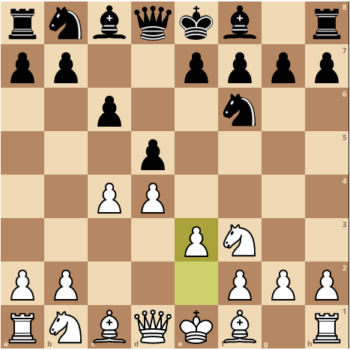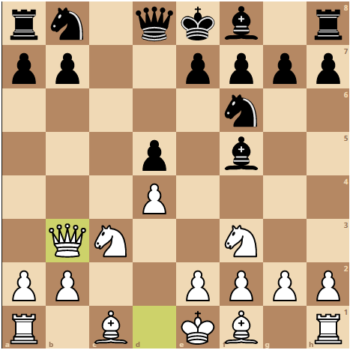The Slav Defense is one of Black’s primary responses to the Queen’s Gambit but also has the reputation to be the safest line. Learn More.
The Slav Defense is one of Black’s primary responses to the Queen’s Gambit characterized by the following moves:
- d4 d5
- c4 c6
Not only is this Opening considered to be one of the most popular responses to the Queen’s Gambit but also has the reputation to be the safest line. Further, players from Beginner level to Grandmasters can comfortably play this line. A key feature of this Opening is that it follows a closed opening pattern and White cannot easily gain an advantage against the Slav Defense.
History
The Slav Defense got its name from the many Slavic players that contributed to the development of the Opening including Semyon Alapin, Alexander Alekhine, and Efim Bogoljubov. The opening started getting explored by various grandmasters in the 1920s however it was analyzed first in the 1590s and Steintz attempted it in the first official World Chess Championship of 1886.
Theory
The Slav Defense is a solid opening where the Opening has a hidden weapon where Black can capture White’s ‘c’ pawn with the Black ‘d’ pawn and protect the pawn by playing b5 on the next move. Slav Defense is an opening aimed to fight from the center and the c6-d5 pawn chain is a very good start towards that plan. In the Queen’s Gambit Declined variation, the light square Black Bishop’s movement is restricted and White has more central control than Black. These problems do not arise in the Slav Defense.
Black supports the d5 pawn with the c6 pawn and avoids blocking the Black Bishop with e6. Further, if White does decide to play cxd5 then Black can also play cxd5 and the position will be symmetrical.
Mainline
- d4 d5
- c4 c6
- Nf3 Nf6
- e3

e3 is a very strategic move for White since it protects the pawn on d4 and opens the file for White’s light-squared Bishop to protect the ‘c4’ pawn. An early dxc4 would not benefit Black in this position hence the better move for Black would be to play Bf5. This allows the Bishop to develop and allows Black later play the ‘e’ pawn to develop the dark-squared Bishop as well and this line also leads to the Schallopp Variation. This line was mentioned by Grandmaster Boris Avrukh in his “Grandmaster Repertoire 1 – 1.d4 Volume One”
Instead of e3, White can even play Nc3, which is the most basic move one can play against the Slav Defense. The move Bf5 can also be played against Nc3 and White may have a slightly better position after the following moves:
- d4 d5
- c4 c6
- Nf3 Nf6
- Nc3 Bf5
- cxd5 cxd5
- Qb3

Black removes support from the b7 pawn that White can take advantage of, however, this line involves a lesser amount of theory to go through and may be a surprise for some players.
Another variation into the mainline is to respond to Nc3 with dxc4 as the c4 pawn is unprotected. White has to respond with a4 to get back the c4 pawn or else Black would back up the ‘c’ pawn with b5.
Exchange Variation
- d4 d5
- c4 c6
- cxd5 cxd5

This may seem like a symmetrical position but Black has to respond with a calm game maintaining equality. Nc3 is the main response to cxd5 followed by Black playing Nf6. White then brings the Bishop outside the pawn chain by playing Bf4 and Black responds with Nc6. This is then followed with e3 and Bf5 since Black cannot play e6 without developing the light-squared Bishop and this avoids any aggressive lines. Since this variation transforms into a symmetrical position, which is not how the Slav defense usually goes, the variation gives White a slight advantage.
Nc3 Variation
- d4 d5
- c4 c6
- Nc3 Nf6
- e3

This variation usually transposes into the mainlines. If Black plays Bf5, White can play cxd5 which is not considered great for Black; however, previously this was considered to be Black’s best response. If Black does not play Bf5, the following variations take place:
4..a6 – Chebanenko Slav
4..e6 – Semi-Slav
4..g6 – Schlecter Slav
THE g3 VARIATION
- d4 d5
- c4 c6
- Nf3 Nf6
- g3
This is a very rare line where White tries to Bring the light-squared Bishop to g2 which works as an advantage for Black. The White Bishop does not control much of the diagonal since Black has a solid pawn chain.
Statistics
| RESULTS | PERCENTAGE |
|---|---|
| White Wins | 23.09% |
| Black Wins | 45.07% |
| Draws | 31.84% |
Famous Games
The Opening has been regularly played in World Championships by players like Max Euwe, Mikhail Botvinnik and Vassily Smyslov. Vladimir Kramnik used this against Veselin Topalov in 2006, and Vishwanathan Anand used the opening against Kramnik in 2008, Topalov in 2010, and Gelfand in 2012.
Step by Step Learning Process
Books to Refer
FAQ
Why Play the Slav Defense?
This opening has a great score on all chess databases which makes it a great opening to play against the d4 opening. Further, defending Black’s d5 pawn with c6 instead of e6, makes space for Black’s light-squared Bishop to develop. Finally, this opening does not involve excessive theory, making it easy for Beginners to play as well.
Learn Chess. Learn Life Lessons.
Leran Chess from the GrandMasters.
Help your child improve their Strategic Thinking, Critical Thinking, Time Management, etc. through the game of Chess.

This article is technically edited and reviewed by Grand Master Marian Petrov.

CHESS KLUB offers chess classes for kids and adults of all levels. Our coaches include FIDE, National, International and Grand Masters among many.
We offer Online and Classroom coaching.
CHESS KLUB has coaching centers in the US and India now!
More on Slav Defense
More Chess Openings
Learn Chess from the Masters
Do you want to see your kid excel in Chess?



